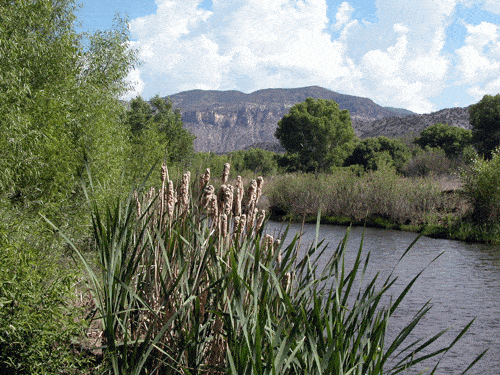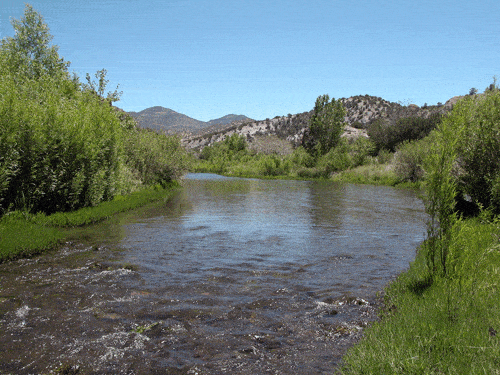Gila River Diversion: Dead In the Water

At last, Gila River lovers can rest easy, knowing that the river in New Mexico is protected from an ecologically harmful and ridiculously expensive diversion. Since the passage of the Arizona Water Settlements Act in 2004, the Upper Gila Watershed Alliance, with its partners in the Gila Conservation Coalition, has been working to protect the Gila River. In 2021, we won!
But there’s still work to be done. The question before us now is how to allocate more than $80 million in the New Mexico Unit Fund (from Arizona Water Settlements Act) on non-diversion water projects that will conserve water, equitably serve the greatest number of people in southwest New Mexico, and protect the river and its native flora and wildlife. Taking into consideration recommendations from New Mexico’s Water Trust Board, this decision will ultimately be made by another state agency, the Interstate Stream Commission.
For more than 15 years, UGWA fought for the Gila River. You can be sure that we will continue to push for water security in southwest New Mexico while protecting the Gila.
America’s First Wilderness River Deserves Wild and Scenic River Designation

The headwaters of the Gila River arise in the heart of the Gila Wilderness Area – the nation’s first designated wilderness – making the Gila America’s First Wilderness River.
A permanent way to protect the Gila River and its major tributaries is through Wild and Scenic River legislation passed by Congress and signed into law by the president. When passed, the M.H. Dutch Salmon Greater Gila Wild and Scenic River Act, championed by New Mexico Senators Martin Heinrich and Ben Ray Luján, will protect about 450 miles of rivers and streams, almost all of them in the Gila National Forest, including the Gila and Aldo Leopold Wilderness Areas.
Passage of this legislation would ensure that river and stream water quality is maintained and would restrict activities that could harm the values for which the river segment was designated. It would prevent the construction of new dams or other harmful water developments.
Wild and Scenic River designation preserves current uses of the river segment. It has no effect on hunting or fishing, and neither prevents current public access nor opens up private lands to the public. If livestock grazing presently takes place on land next to a designated river segment, such use can continue as long as it does not degrade the values for which the river reach was designated.
In short, Wild and Scenic River status keeps the designated river or stream as it is today, to be enjoyed by future generations.
Thank you to the Conservation Lands Foundation for funding to work on Wild and Scenic River designation.
Community Rises Up to Protect the Gila’s Serenity
The U.S. Air Force is once again targeting southwest New Mexico. It is proposing a modification of 10 existing Military Operations Areas (MOAs) in southwest New Mexico and southern Arizona. This proposal would authorize Air Force military trainings above rural and tribal communities, wilderness areas, and national monuments. The military training missions would allow jets to fly as low as 500 feet above ground level in some places, and at speeds faster than 600 miles per hour. Some flights would be at supersonic speeds – and cause sonic booms – at just 5,000 feet above ground level.
This current Air Force proposal is different from the one we defeated a few years ago. This is the second time in the last decade that the U.S. Air Force has set its sights on the Gila National Forest and surrounding area for military trainings that would seriously degrade wildlife habitat, wilderness areas, and our quiet way of life.

The current Air Force proposal isn’t quite as egregious as the previous one, but it’s still bad enough. In southwest New Mexico, the latest Air Force proposal would:
- lower the supersonic jet flight altitude from the current 30,000 feet above ground level (AGL) to as low as 5,000 AGL
- maintain the minimum altitude for low-level military jet maneuvers as low as 1,500 feet AGL in the Morenci MOA and as low as 5,000 feet AGL in the Reserve MOA
- cause extreme noise and sonic booms above dozens of rural communities and sensitive natural areas
- distress wildlife and domestic animals
- degrade quality of life and outdoor recreation and tourism opportunities
The Air Force plans to release its Draft Environmental Impact Statement in fall 2023. At that time, UGWA and our partners in the Peaceful Gila Skies coalition will review the DEIS and write substantive comments in response. Stay tuned for opportunities to attend Air Force public meetings and submit comments in opposition to the proposal.
We’ve all heard that “you can’t fight City Hall,” but the people won the last fight against the Air Force! In 2017, Holloman Air Force Base near Alamogordo, New Mexico, proposed to conduct military trainings over 7 million acres, including the Gila National Forest and its three Wilderness Areas: the Aldo Leopold, Gila, and Blue Range. Holloman had threatened to fly 10,000 annual sorties (a sortie is defined as a flight leaving and returning to Holloman Air Force Base), an average of 30 per day.
As if noisy daily disruptions weren’t bad enough, Holloman had also planned to drop 15,000 flares annually over the Gila National Forest, greatly increasing the risk of wildfires. The military jets would also have released 15,000 bundles of chaff, each containing millions of tiny aluminum-coated fibers that could harm wildlife and air and water quality.
The community swiftly and vehemently opposed the Holloman proposal. UGWA and other conservation groups and concerned individuals responded to the threat by creating a coalition to educate ourselves and the public about potential impacts, and get people to attend Air Force meetings and submit comments in opposition to the proposed action.
Fortunately, we prevailed in the end. In early 2021, Holloman Air Force Base released its decision to conduct military trainings close to Alamogordo, over lands that are heavily impacted by oil and gas extraction.
For more information on the current threat, please visit the Peaceful Gila Skies website at https://peacefulgilaskies.com/
Peaceful Gila Skies is a coalition of business owners, community leaders, sportsmen and concerned citizens, and conservation groups: Center for Biological Diversity, Gila Conservation Coalition, Gila Resources Information Project, Heart of the Gila, New Mexico Wild, and Upper Gila Watershed Alliance.